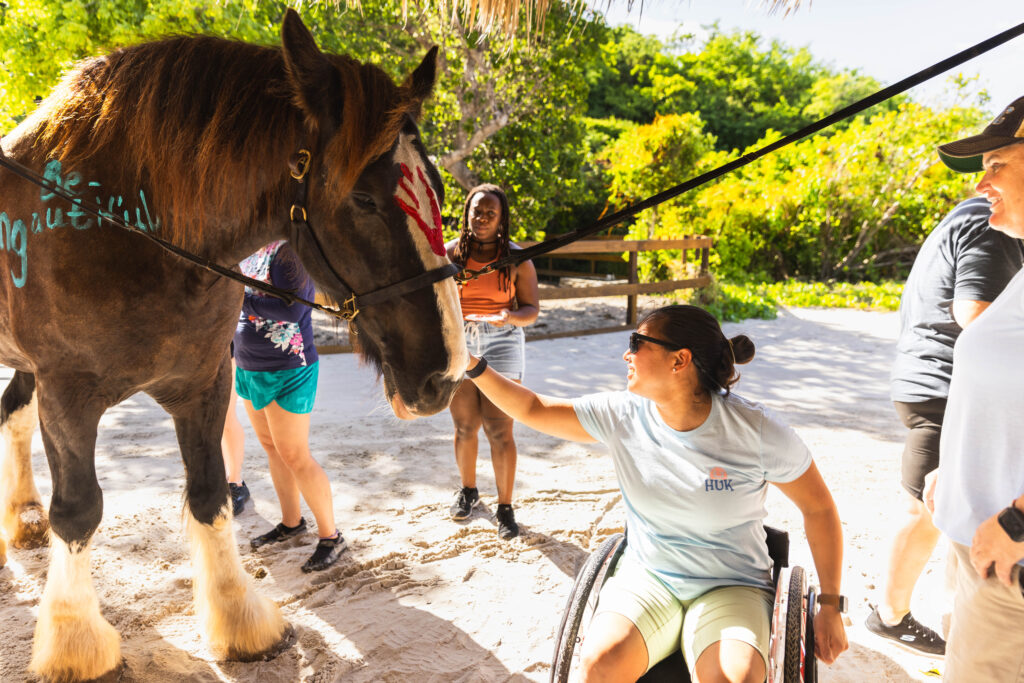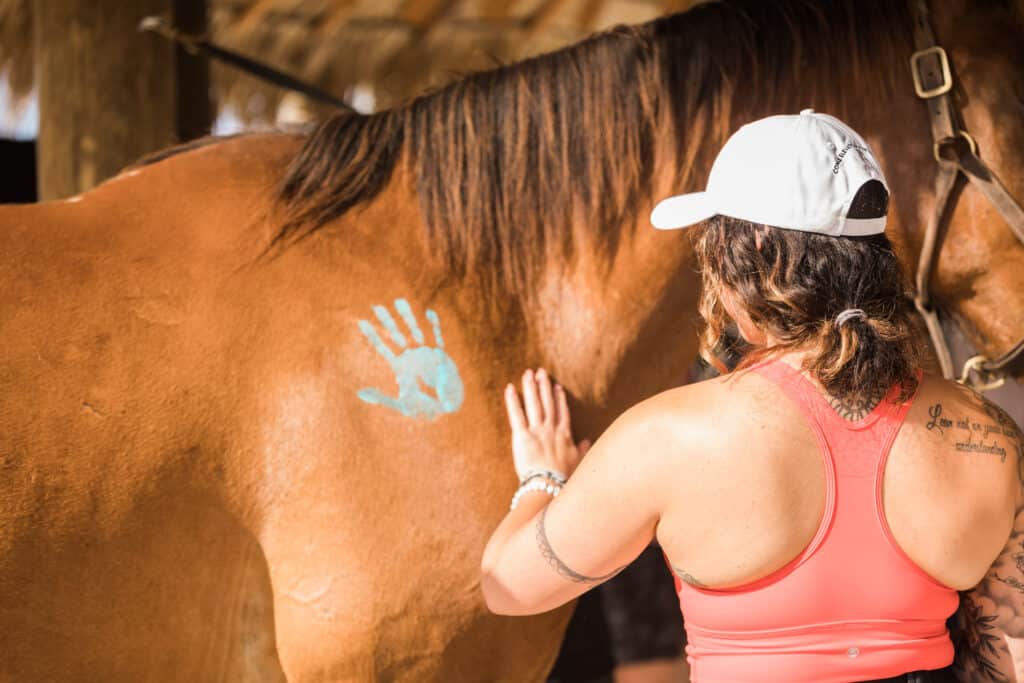“Equine therapy” is an umbrella term that refers to various therapy approaches involving interaction between a horse and a human. Often referred to as horse therapy or equine-assisted therapy, it can include tasks like riding, grooming, or leading a horse. Many consider equine therapy a highly therapeutic process to help individuals heal physically and emotionally.
Nowadays, anyone looking for non-conventional healing methods may consider equine therapy. From enhanced physical mobility to improved emotional well-being, equine therapies can provide various health benefits for people of all ages and abilities.
What are the Different Kinds of Equine-Assisted Therapy?
There are several different types of horse therapies available today. Whether through therapeutic horseback riding or equine-assisted learning, horse therapies can offer a participant everything from improved balance and coordination to developing critical life skills. Other equine-based activities, alongside the calming presence of horses, may also help to reduce stress and anxiety.
While equine therapy has evolved over time, both traditional and adaptations of equine-based treatments are gaining popularity among those seeking alternative healing methods. Some of the most common horse therapy techniques in use today include the following:

1. Therapeutic Horseback Riding
Therapeutic horseback riding is an alternative therapy that uses horseback riding and interaction with horses to promote mental, emotional, and physical well-being. Therapeutic horseback riding is commonly used to improve balance, coordination, and strength and can be adapted to individuals who struggle with specific cognitive, physical, or mental health issues.
While the relationship developed with the horse can improve emotional and social skills during a therapeutic riding session, this type of therapy typically focuses on the horse’s movement. It is thought that therapeutic riding helps to engage and stimulate specific muscle groups.
Some of the benefits of therapeutic horseback riding include the following:
- Improved coordination and motor skills
- Faster reflexes and range of motion
- Improved breathing and circulation
- Integration of the senses
- Increased feelings of well-being
- Improved self-esteem
- Improved risk-management skills
- Better self-control and emotional control

2. Hippotherapy
Hippotherapy is a form of equine therapy that uses a horse’s movement to address sensory, physical, and cognitive impairments. Although relatively new, hippotherapy is becoming well-known in the field of equine therapy as one of the more effective ways to treat physical, occupational, and speech impairments. Hippotherapy can also be used to address trauma and grief.
How Does Hippotherapy Work?
Hippotherapy uses the movements of a horse, also known as gait, to stimulate the rider’s muscles and nervous system. This can help promote improvements in balance, coordination, strength, and overall functioning. A speech and language therapist, occupational therapist, or physical therapist usually works alongside a riding instructor in the hippotherapy session.
The following are some of the advantages of hippotherapy:
- Increased core strength
- Improved postural control
- Increased balance and coordination
- Improved sensory integration
- Improved motor coordination
Anyone is welcome to try hippotherapy. Hippotherapy is typically led by a licensed professional who uses a horse as a therapeutic instrument in a range of wellness and therapy contexts.

3. Equine-Assisted Psychotherapy (EAP)
Equine-assisted psychotherapy (EAP), also known as equine-facilitated psychotherapy or equine-facilitated mental health, is a type of therapy that uses horses as a therapeutic tool to help individuals with specific emotional, behavioral, and mental health problems. The Equine Assisted Growth and Learning Association (EAGALA) is the primary reference point for this type of therapy.
In EAP, the relationship of mutual trust and respect built with the horse creates a safe environment that enables change (pages 9-10 of the PDF). Because of this, EAP could be suitable as a complementary mental health treatment for some individuals.
EAP sessions are conducted by licensed therapists or mental health professionals who have received specialized training in equine therapy. During therapy sessions, the individual interacts with the horse and may engage in care activities, groundwork, and role-playing activities with the horse to help them identify and work through emotional and behavioral issues.
Some of the significant benefits of EAP are as follows:
- Improved self-confidence
- Improved communication skills
- Improved emotional regulation
- Reduced anxiety, depression, and grief

4. Equine-Assisted Learning and Equine-Assisted Activities
Equine-assisted learning (EAL) uses horses as a teaching tool to assist people in learning particular skills. Social skills, communication skills, leadership skills, and problem-solving abilities can all be enhanced with EAL. A Singapore-based study demonstrated that equine-assisted learning can help at-risk youth build character skills and consequently improve their grades.
During EAL sessions, the individual interacts with the horse in various equine-assisted activities and exercises to promote specific skills. A participant in equine-assisted learning may engage in any of the following activities:
Horsemanship skills: Participants learn how to handle and communicate with horses with ground exercises. Tasks could include leading the horse through an obstacle course to develop leadership skills or grooming the horse to promote social skills and empathy.
Emotional regulation: Horses are sensitive animals and can mirror human emotions in behavioral ways. EAL activities allow participants to recognize and regulate their emotions while interacting with horses. Activities may include practicing deep breathing, relaxation techniques, and mindfulness exercises to help manage stress and anxiety.
Communication: Effective dialogue, respect, and encouragement are necessary when working with horses. Certain EAL activities work to help participants communicate effectively and assertively with horses. Even non-verbal individuals can practice communication through non-verbal signs and cues. Communication activities during equine-assisted learning can help foster confident body language, voice commands, and boundaries.
Leadership and self-confidence: Participants can assume leadership roles and learn how to guide a horse through various activities, such as leading the horse. By honing in on their decision-making skills, participants can improve their confidence and assertiveness. These encounters may also improve the participant’s personal development and capacity for leadership in other aspects of life.
Nurturing creativity: Horses offer an exciting but calm atmosphere that can help stimulate the participant’s imagination. Activities that help promote creativity may involve trying to think of creative solutions for problems they encounter when working with a horse. This could include challenges like getting the horse to walk backward or picking up the horse’s leg to clean its hoof.

5. Equine-Facilitated Personal Development
Equine-assisted personal development (EAPD) or equine-facilitated personal growth is usually practiced outdoors and is considered an experiential therapeutic approach that helps people communicate more effectively through body language and ultimately become their best selves. EAPD can be practiced by riding horses or may utilize groundwork exercises such as obstacle courses or problem-solving interactions that help the individual get through emotional roadblocks and acquire new life skills. Often facilitated by a horse professional and licensed therapist, equine-assisted personal development can be an alternative to “talk therapy” and help open the doors to emotional growth and learning.

6. Equine-Facilitated Wellness
Equine-facilitated wellness (EFW) integrates multiple types of equine therapy into a comprehensive wellness program. EFW programs may include aspects of therapeutic riding, hippotherapy, equine-assisted psychotherapy (EAP), and equine-assisted learning (EAL) to promote emotional, mental, and physical healing. Equine-facilitated wellness is often customized to meet the unique goals of each participant.
Getting Started With Equine Therapy
Equine therapy can be found at specialized equine therapy centers, rehabilitation facilities, hospitals, or through private practitioners. It is also worth consulting with local therapists, medical and mental health professionals, or equine organizations for recommendations and information on where to find equine-assisted therapy programs in your area.
Before starting any new type of therapy, it’s essential to find a certified and experienced equine therapist or program. They can assess your needs and goals and create a personalized treatment plan. It is also vital to ensure that the equine therapy provider has well-trained horses that are suitable for therapeutic work. For instance, the horses at Redemption Ranch that work with participants in our equine therapy retreats have undergone rescue and recovery and now serve as therapy animals for guests and locals of the BVI. Our ranch provides a unique environment in which to experience the healing power of connection with horses.
What Are The Benefits of Equine Therapies?
Connecting with horses and engaging in activities such as riding, grooming, or interacting with the animals can help improve physical, emotional, and cognitive well-being. Many types of equine therapy can help with self-confidence, communication skills, and emotional regulation. Depending on your specific needs and goals, you can find a horse therapy type that works best for you.
While every kind of horse therapy is slightly different, here are some of the general benefits a client may expect to get from equine therapies:
- Reduction of stress, anxiety, and depression
- Enhancement of social skills and emotional regulation
- Improved self-esteem and self-confidence
- More self-awareness
- Increased coordination, balance, and muscle strength
- Decreased anger, dissociation, and aggression
Experience the Transformative Power of Equine Therapy
Equine therapy is gaining momentum as a popular alternative treatment due to its ability to improve a wide range of physical, emotional, and psychological afflictions. Tuning into the rhythmic and calming nature of horseback riding may help reduce stress and anxiety among participants.
The bond formed between humans and horses during therapy sessions can create a sense of connection and leave a long-lasting impression. Whatever your personal goals and challenges are, equine therapy has the potential to change your life for the better!